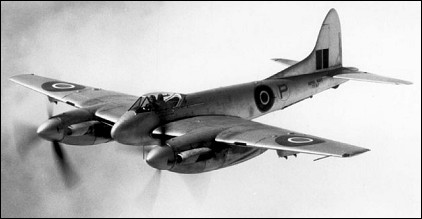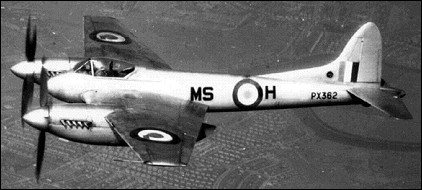|
| The twin-engined Hornet fighter was designed to Specification F.12/43 and the first prototype flew on 28 July 1944. It entered production at the end of 1944 and deliveries were made to the RAF from February 1945. Four versions were produced for the RAF as: the Hornet F.1 medium-range single-seat fighter with four 20mm cannon and provision for carrying two 450kg bombs or two 455 litre drop tanks; Hornet PR.2 long-range unarmed photographic
reconnaissance aircraft; Hornet F.3 long-range single-seat fighter with the increased fuel tankage of the PR.2; and Hornet FR.4 with a vertically mounted camera. More than 200 were built. The Hornet was the fastest twin piston-engined operational combat aircraft in the world while in service and the first aircraft to demonstrate a cartwheel manoeuvre. Operated in Malaya in the early 1950s, the type was finally withdrawn from service in 1955.
The Sea Hornet was a naval adaptation of the RAF Hornet. It was fitted with folding wings and had provision for deck arrester and RATO gear. Air-draulic shock-absorber legs replaced the rubber-in-compression legs to eliminate bounce in carrier landings. Three versions were built as: the Sea Hornet F.20 carrier-based medium-range single-seat fighter/reconnaissance/strike aircraft, capable of carrying eight 27kg rockets, bombs, mines and drop-tanks; Sea Hornet NF.21 carrier-based two-seat night fighter/reconnaissance/strike aircraft fitted with an A.I. radar scanner in a thimble radome in the nose; and Sea Hornet PR.22 carrier-based medium-range photographic-reconnaissance version of the F.20. The F.20 first entered service with No.801 Squadron, FAA and joined HMS Implacable in 1949. A total of 200 Sea Hornets were built.
| MODEL | Hornet F. Mk 3 |
| CREW | 1 |
| ENGINE | 2 x Rolls-Royce "Merlin" 130/131, 1544kW |
| WEIGHTS |
| Take-off weight | 9480 kg | 20900 lb |
| Empty weight | 5840 kg | 12875 lb |
| DIMENSIONS |
| Wingspan | 13.72 m | 45 ft 0 in |
| Length | 11.18 m | 37 ft 8 in |
| Height | 4.32 m | 14 ft 2 in |
| Wing area | 33.54 m2 | 361.02 sq ft |
| PERFORMANCE |
| Max. speed | 760 km/h | 472 mph |
| Ceiling | 10670 m | 35000 ft |
| Range | 4820 km | 2995 miles |
| ARMAMENT | 4 x 20mm cannons, 900kg of weapons |
| Don, e-mail, 27.09.2009 19:05 Just for information sake, there was one Hornet sent to Canada for cold weather testing. It was surplussed to Spartan Aviation, a high altitude surveying and Photo company. They used a lot of Mosquitos in their work and got the one Hornet that was sent here. Don't know what happend the the airframe. reply | | mike, e-mail, 20.04.2009 22:28 Quite a large number were expended on steam catapult trials in the 1950's when thay were simply shot into the sea from carriers. Such was the rush towards jet propulsion, oh what a waste. reply | | Mark, e-mail, 14.10.2008 03:14 No chance of an airframe surviving. The reason for the scrapping and burnrng of the airframes was a combination of rot and disbonding of the laminated wood-to metal structures, both caused by exposure to the Malasian climate and improper storage at the depots. Unsafe and outdated, they were burned for purely economical reasons. Cheaper than trying to totally dismantle and dispose of them. reply | | peter, e-mail, 23.02.2008 02:36 i understand that loads of hornets were scrapped? surely theres got to be a few airframes lurking in woods or jungles in the far east!! if theres one, lets hope it can be made to fly if poss,it would be really good! reply |
|
Do you have any comments?
|
| 
COMPANY
PROFILE
All the World's Rotorcraft
|







